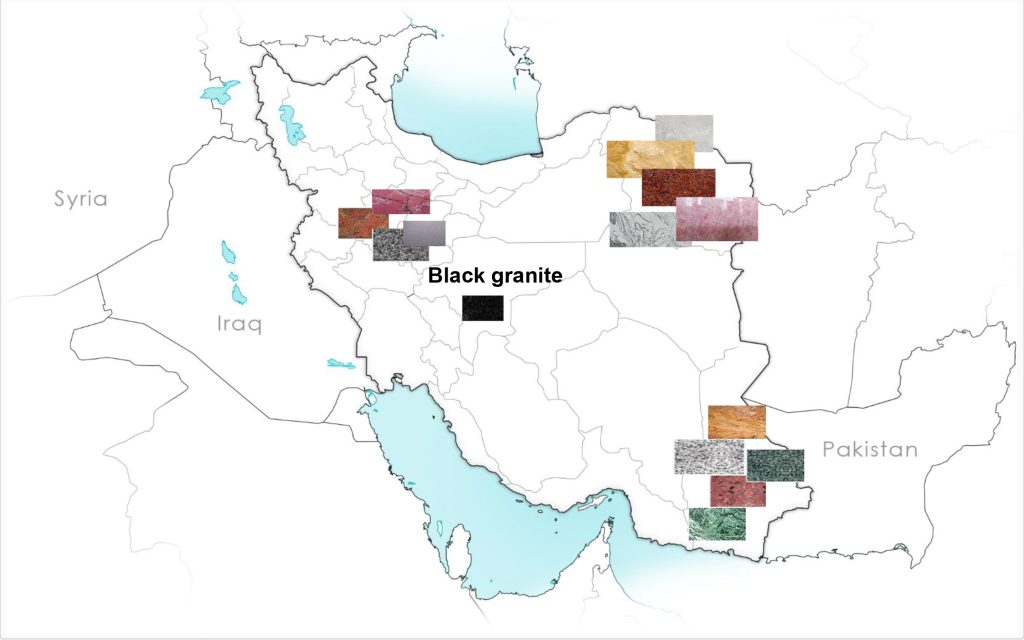- Kharmroud Granite Mine in Kerman Province, ranked as the third-largest underground mine in 2021.
- Shahrkord Marble Mine in Chaharmahal and Bakhtiari Province, one of the world’s largest white marble mines.
- Mehrbin Travertine Mine in Isfahan Province, known for high-quality travertine with diverse colors.
- Mehriz Onyx Mine in Yazd Province, recognized for its beautiful and transparent onyx.
- North Khorasan Limestone Mine in Khorasan Razavi Province, suitable for chemical and cement industries.
- Garmsar Salt Mine in Semnan Province, known for high reserves and good quality salt.
These stones are distributed across various geographical regions in Iran. For example, granite is mostly found in the southeast, marble in central and western regions, travertine in central and northern areas, onyx in central and eastern regions, limestone in northern and eastern areas, and salt in central and eastern Iran.
Most granite mines in Iran are located in provinces such as South Khorasan, Razavi Khorasan, West and East Azerbaijan, Isfahan, Zanjan, Yazd, Hamedan, Fars, Kerman, Sistan and Baluchestan, and Gilan.

- Natanz Black Granite Mine in Isfahan Province, one of the largest black granite mines in Iran and the world, known for uniform black color and overall texture, suitable for construction and decoration purposes.
- Toiserkan Granite Mine in Hamedan Province, one of the oldest granite mines in Iran, featuring various colors like red, pink, gray, white, and black, suitable for construction and decoration.
- Zahedan Granite Mine in Sistan and Baluchestan Province, known for high-quality granite with various colors such as brown, yellow, green, pink, and gray, suitable for construction and decoration.
- Nehbandan Granite Mine in South Khorasan Province, one of the high-quality granite mines in Iran, featuring various colors like red, pink, yellow, white, and black, suitable for construction and decoration.
The capacity for the production of construction and decorative stones in Iran, according to the Ministry of Industry, Mining, and Trade, is 47 billion tons. However, the actual production of these stones in 1399 (Iranian calendar) was only 13.5 million tons, indicating that a significant portion of Iran’s stone mining capacity remains unused or underutilized.
The prices of Iranian stones vary depending on the type, quality, size, thickness, packaging, and destination for export. For instance, according to 2019 statistics, the average price of Iranian granite in the global market was around 25 dollars per square meter for cut and packaged stones with a thickness of 2 centimeters, based on FOB Bandar Abbas Incoterms.
- Stone cutting factories in Iran use advanced technologies and modern machinery to cut natural stones like marble, travertine, granite, limestone, and onyx into various shapes and dimensions for consumption.
- These factories are usually located near stone mines to reduce transportation costs and production time. Some provinces with numerous stone cutting factories include Isfahan, Razavi Khorasan, Fars, East Azerbaijan, West Azerbaijan, Kerman, Yazd, Hamedan, Markazi, Semnan, Qazvin, Kurdistan, Gilan, and Mazandaran.
- These factories enhance the surface and quality of stones using methods such as calibration, polishing, honing, and tumbling. Additionally, they protect stones from potential damage during transportation by using various packaging methods such as wooden boxes, polyethylene, foam, thermocouples, and plastic belts.
- Stone cutting factories in Iran transform stones into various shapes and patterns, including mosaics, slabs, slate stones, wall stones, columns, sculptures, and artistic pieces, based on the needs and preferences of customers.
- Russia is a significant market for the export of Iranian stones, importing around 1.2 million tons of stone from Iran in 2019, constituting 10% of Iran’s total stone exports.
- Stones imported by Russia from Iran primarily include construction and decorative stones such as marble, travertine, granite, limestone, and onyx. These stones are used in various construction and artistic projects in Russia.
- According to the Ministry of Industry, Mining, and Trade of Iran, Iranian marble with 40% of total stone exports to Russia has the largest share, followed by Iranian travertine with 30%, Iranian granite with 20%, and other stones with 10% of total stone exports to Russia.
- The prices of Iranian stones depend on their type, size, thickness, quality, and packaging methods. In general, cut stones are more expensive than raw stones. Additionally, stones with beautiful and uniform colors and textures command higher prices.
- Based on the average prices of Iranian stones in the global market in 2023, one square meter of Iranian granite is priced between 10 to 40 dollars, one square meter of Iranian marble between 15 to 60 dollars, one square meter of Iranian travertine between 10 to 30 dollars, and one square meter of Iranian onyx between 50 to 200 dollars.
- The export ports for Iranian stones are usually in southern and Persian Gulf ports. Some of these ports include Bandar Abbas, Bandar Bushehr, Bandar Imam Khomeini, Chabahar, and Bandar Kangan.
- For exporting Iranian stones to neighboring and regional countries, northern ports and Caspian Sea ports can also be used. These ports include Bandar Anzali, Bandar Nowshahr, Bandar Amirabad, and Bandar Fereydounkenar.